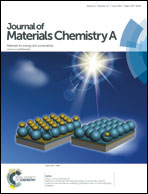LixV2O5/LiV3O8 nanoflakes with significantly improved electrochemical performance for Li-ion batteries†
Abstract
Poor cycling stability and rate capability are the main challenges for LiV3O8 as the cathode material for Li-ion batteries. Here a novel strategy involving the self-transformation of superficial LiV3O8 in a reducing atmosphere (H2–Ar) was reported to fabricate LixV2O5/LiV3O8 nanoflakes. X-ray diffraction (XRD), X-ray photoelectron spectroscopy (XPS) and high resolution transmission electron microscopy (HRTEM) results demonstrate that LixV2O5/LiV3O8 nanoflakes could be in situ formed and that the thickness of the LixV2O5 layer is controllable. When used as a cathode for a Li-ion battery, the LixV2O5/LiV3O8 nanoflakes exhibit significantly improved cycling stability with a capacity retention of ca. 82% over 420 cycles at a 1 C-rate (1 C = 300 mA g−1), and much better rate performance compared with bare LiV3O8. The improvement of the electrochemical performance could be attributed to the unique core–shell structure, in which the ultrathin LixV2O5 layer could not only protect the internal LiV3O8 from dissolution, but also increase the Li ion diffusion coefficient and suppress the charge-transfer resistance, as verified by electrochemical impedance spectroscopy (EIS) and XRD results.


 Please wait while we load your content...
Please wait while we load your content...